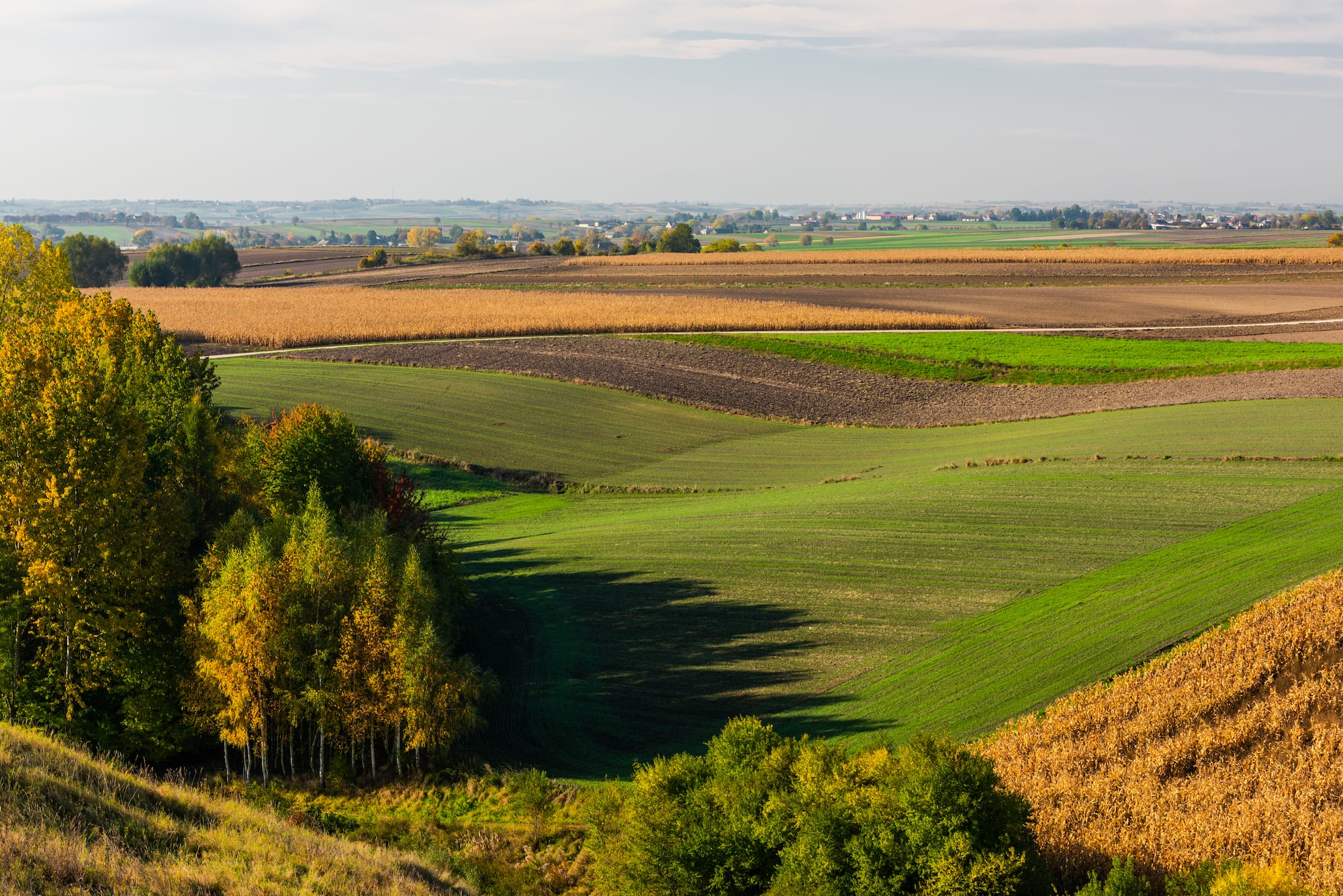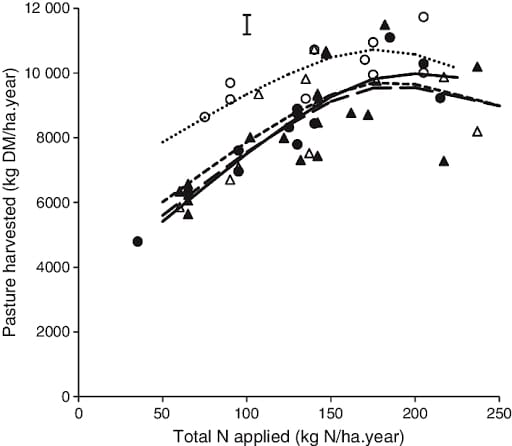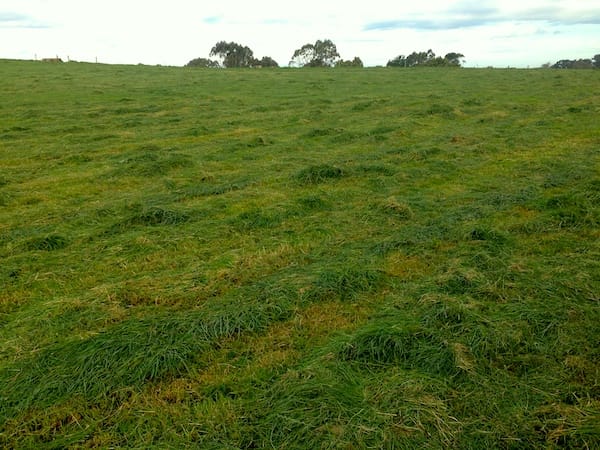Managing your pasture, in the same way, all year round – simply isn’t enough.
Not if you want to get a dense and nutritiously-rich pasture as feed for your cows. Each season offers you, the dairy farmer, opportunities to improve your pasture.
Considering the many benefits of having an exceptional pasture as feed for your cattle – that’s not something to easily ignore. Your dairy farm’s profit depends on the amount of pasture you produce a year as well as the quality of the pasture.
You will defo sense the difference in profit if you have a maximum production of pasture of 18 to 20tDM/ha.year or much much less than that.
Can you really get production of 18 to 20t of pasture per ha each year? Yes, if you not only manage your pasture in an ideal way but you also need the environmental conditions.
These, however, can, more or less, be moulded to reach close to ideal conditions through irrigation and fertilisation. However, you need to take advantage at the best of the opportunities of every season, to maximize the production of your pasture.
You’ll be grinning like a shot fox to know we have compiled of tasks to do each season, which benefits your pasture to the maximum! So you can get the most out of your pasture and have a dairy farm with the highest profit possible.
Let’s get cracking then, with our first and most important Southern Hemisphere season for your pasture - Spring!
1. Spring Pasture Management
2. Summer Pasture Management
3. Autumn Pasture Management
4. Winter Pasture Management

1. Spring Pasture Management
Intensive Grazing
Spring is the best season to do a long run of intensive grazing.
Besides being one of the best seasons for your cows to be the most out in the sun – it’s also the best season to graze your grass – for your grass.
Intensive grazing in spring will increase pasture production for spring and summer, and will also increase your milk production during summer. On top of these benefits, one study also confirms that due to more intense grazing during springtime, you will have an increase in the quantity of spring herbage available for conservation or fodder.
What is intensive grazing? It’s grazing with an intensity that is above normally accepted levels. What are normally accepted levels? Well, rotational grazing can have intensity from two pastures, 15 pastures, 30 pastures or even more than 30 pastures.
So, when spring comes - push the intensity of your grazing and you’ll get a higher production of much better pasture, along with a higher production of milk.
Soil sampling and soil testing
Spring offers the ideal temperature and weather environment for you to take helpful soil samples for a soil test.
You should only take a soil sample when your ground isn’t frozen. Of course, that implies you can take one in fall, summer and during the months of winter when the temperature is up. However, it’s not recommended as much as it’s recommended during spring.
During summer and fall, the nutrient levels are in general much lower than they are during winter and spring. So, when spring comes, take out your soil sampling kit and do a sample. Find out more in our guide on soil sampling and soil testing.
Once you have a soil test done then you can prepare for something else that is important for dairy farmers during spring – fertilising. Also, make sure to do a soil test at least every two to three years, if not annually.
Grass fertilisers
Nitrogen is a key ingredient to healthy soil and healthy pasture. It’s also a key ingredient in a dense nutritious pasture for your cattle. Which means better feed – healthier happier cows – more milk production.
You should definitely do a soil test before applying nitrogen to your pasture. Since it’s such an important nutrient for it – you need to know how much of it there already is in your soil.
Fertilising your pasture with nitrogen will cause the-so-called spring flush of pasture. Right when your pasture is taking on that beautiful green colour during spring, applying exactly the amount of nitrogen that it needs, will give it a nice jumpstart to becoming a lush productive pasture.
How much nitrogen does pasture typically need? Around 225 kg/ha per 1 tonne of grass – just for maintenance. It’s recommended that you add 70 kg in spring, some 55 kg more in mid-December and then sprinkle 45 kg more in February.

The above chart shows how N can help dairy farmers harvest significantly more kg of pasture DM/ha/year. From 50 kg to 200 kg of nitrogen per year can yield 10,000 kg DM/ha each year.
However, nitrogen isn’t the only fertiliser that does well to your pasture. Your grass will also enjoy and eat up some other fertilisers as well. Phosphorus and potassium are two more nutrients which are favourites to your pasture and which do wonders for it. We recommend between 115 and 225 kg/ha of phosphorus and between 180 and 400kg/ha of potassium.
A fourth nutrient that is excellent for your pasture and great to add during spring is – lime (calcium carbonate). Lime is fantastic for your soil if it has a low level of pH. Lime helps adjust the pH level in your soil and raise it up. H
However, you should do a soil test before applying lime – and keep in mind that it takes around 6 months for lime to start kicking in. Why is this important? You’ll want to apply it 6 months before seeding or reseeding your pasture.
Performing a soil test and adding the correct amount of nutrients to your pasture in spring will give you a great advantage. This way your pasture can get plenty of nutrients to grow grass steadily, rapidly and richly all throughout the year.
All for your cows and their well-being so they can produce the most and best milk that they can. While maintaining their health and stamina!
As a dairy farmer, you’re as happy as your least happy cow! So, make sure they’re all happy.
Weed growth control management
Yes, you heard that right – and I’m sure you know its importance. There is such a thing as weed growth control management – which isn’t handpicking weeds while you pass through your pasture.
What you first need to do is identify the species of weeds that you have in your pasture. Then simply select the herbicide suited to deal with them and get cracking with spraying. The Australian Government provides a list with images of the most common weeds in Australia. Browse through them and you’ll surely be able to pinpoint which ones have made a home for themselves in your pasture. It will then be much easier to choose an effective and efficient herbicide to kill’em off.
Regular topping
Regular topping is also another pasture management strategy that can give you a good result in spring. Regular topping encourages the replacement of leaves in the plants, instead of seeding.
Pasture topping is a great technique to do to increase the volume and quality of your pasture as well as your pasture growth. What you do, when you to pasture topping, is you mow your paddocks before or after grazing with a mower attached to your tractor.

If you want to know even more about pasture topping we have some great content for you here.
As you can see, spring is a very important season – it’s actually the most important season for your pasture.
So, don’t let it pass without taking action and taking advantage of all the season’s opportunities.
Let spring make your pasture thrive – but only if you work on it too!
But what about summer? Let’s see!
2. Summer Pasture Management
Summer isn’t an overly important season for pasture management. We’re sorry to say say that, summer!
Pasture Management plan
It is, however, the best time to evaluate your pastures, especially since the grasses are not sleeping during this season. To do this, make sure that you observe how much bare ground you have, how much desirable cover, and how much weed growth cover there’s in your pasture. Doing this will give you more information which can help you decide on the best plan for your summer pasture management.
No overgrazing
One thing though, during the summer it’s very important that you don’t overgraze.
Why? It can double its negative impacts. The lack of moisture mixed with the high temperatures can already cause the death of your grasses and desirable plants.
If you add overgrazing to that cake, you’re pretty much doomed.
Summer grasses
Something else that can help with summer grazing is planting warm-season grasses, such as Bermuda grass and crabgrass, among a few others. Warm-season grasses adapt to higher temperatures and require much less water to produce a lot of pasture. These characteristics make them really good options for summer grazing. So, give them careful consideration!
Continuing with fertilisation
If you remember from above, during spring is a great time to start fertilising your pasture with nitrogen. However, fertilisation should be spread out and continued during summertime. As we’ve mentioned above, in mid-December you can continue to add 55 kg/ha of nitrogen and in February another 45 kg/ha.
But in the end, more or less, during summer you just need to go on with your regular pasture management plan. If during springtime-intensive grazing on an above-accepted level was recommended – the opposite is true during summer.
Resting your pasture
If you want to do high-quality pasture management - you need to practise leaving paddocks to rest. Fencing is important to have as boundaries between your paddocks - so you can graze some, irrigate or fertilise others, spray others and then some paddocks you can rest.
Ideally, you should start grazing when your feed wedge pre-grazing cover is around 2800 to 3000 KgDM/ha, and you target a post grazing of 1500 to 1700 KgDM/ha. That’s the time when you need to leave your pasture to rest and grow back.
How many paddocks do you need though to be able to graze some and leave sufficient rest to others? There is a simple formula to calculate this - Days of rest needed to be divided by days of grazing + 1. During summer your grass might need around 30 days to grow back to 2800 to 3000 KgDM/ha, and if you graze your cows around 5 days on a paddock - your formula would be something like this: 30/5 +1 = 6 +1 = 7. You will need 7 paddocks to be able to feed your cows and let some of your grass rest and grow back while bathing in the summer’s sun.
The above formula is very simple and I'd recommend factoring pasture growth rate, leaf emergence, herd requirements. Of course this can get complicated quickly and take up a lot of brain space. This is the fundamental reason why Pasture.io started.
Are we at autumn yet? We are now.
3. Autumn Pasture Management
Autumn is the right season to start preparing your pasture for wintertime resting and then spring renewal.
Grass Reseeding
This season offers a great opportunity for grass reseeding. It’s a phenomenal time because the temperature starts going way down making cool-season grasses thrive and boom. This all depends on if you have planted summer grasses during - obviously summertime or spring - or if you have kept ryegrass all throughout the year.
You can test your pasture for the type of grass towards the beginning of autumn. If you look at your pasture and you see it mostly green and thriving - it means you have cool-season grass. If your pasture is mostly brown - then its summer grasses and it’s fading and dying. Which means, it’s time to reseed your pasture!
Reseeding is an option and solution for dead grass - but it’s also a solution to improve and raise milk production. A reseeded pasture typically gives 8% more milk output per hectare because the new grass has a lot more richness, nutrients and value. Considering the hard-times that dairy farmers are going through, especially in Australia, this 8% is more significant than imaginable.
Kill those weeds
Autumn is similar to spring - a good season to herbicide weeds. because this is the season when these perennial weeds are transferring their energy reserves down to their roots. Spraying them with herbicide in the fall will allow them to pull the chemical into their roots.
Why is autumn again a good season to take care of your pasture’s weeds? Because this is the season when these perennial weeds are transferring their energy reserves down to their roots. Spraying them with herbicide in the fall will allow them to pull the chemical into their roots. And basically, die faster :)
3rd wave of fertilisation
In autumn, you have the opportunity to apply the 3rd wave of fertilisers.
It’s a great time to apply lime, phosphorus, and potassium to your soil as these nutrients will help your roots regenerate and grow back stronger than ever.
Before any application, you should definitely do soil testing. If the pH is below the recommended level for the forage species thriving in your pasture, it is time to apply lime. Liming at the recommended rate will help improve soil neutrality, which then helps hasten forage growth and competitiveness against weeds.
Nitrogen is also a good idea as fertiliser during autumn. Considering 225 kg/ha is an appropriate amount of nitrogen throughout the fertilising seasons - spring, summer and autumn - you shouldn’t apply more than 45 kg/ha during autumn. Also, take into account if there is air moisture - as this helps nitrogen to settle into your soil and pasture.
And have we reached winter? Yes, we have managed to reach the winter.
4. Winter Pasture Management
So, winter is coming or has already arrived. What happens to your pasture?
Break from grazing
Winter is the time to give your pasture the break from grazing it so needed.
Why? Because they can damage perennial grass plants through their continuous grazing.
More so, the stomping of the livestock can slice through the soil in wet conditions and can damage the root systems of the grass, further slowing its recovery from winter.
Winter is also the season to think about your pasture and come up with a great pasture management plan for the entire year. This is especially true when you are renovating or reestablishing pastures. These processes are often a multi-year process and should be planned out accordingly.
To do this, you can look at your Pasture.io remote pasture map via satellite and consider the layout of your pasture. Make sure to ask yourself the following questions:
Is there a chance you can do that will make your pasture more efficient?
Is there any need to add facilities such as fencing, improved laneways, or perhaps a feed pad?
If you are implementing the Rotational Grazing System, think of the pasture that you will split into smaller paddocks and answer if all of your livestock can go out together in one group, or is there a need for you to make multiple grazing systems?
Winter is a great time to map out this plan because this is the season to allocate budget and price out any projects you are planning to do for the coming year, may it be reseeding, building a stressed lot, or fencing, among many others.
Also, all throughout the year, our pasture management tool can help you manage every aspect of pasture management: from the obvious grazing plan to keeping track of fertilising and spraying.
Our platform has a wonderful machine learning environment which will take all your data and turn it into valuable information for you to use in your decision-making. Start your account today.
Happy farming!
- The Dedicated Team of Pasture.io, 2019-11-13